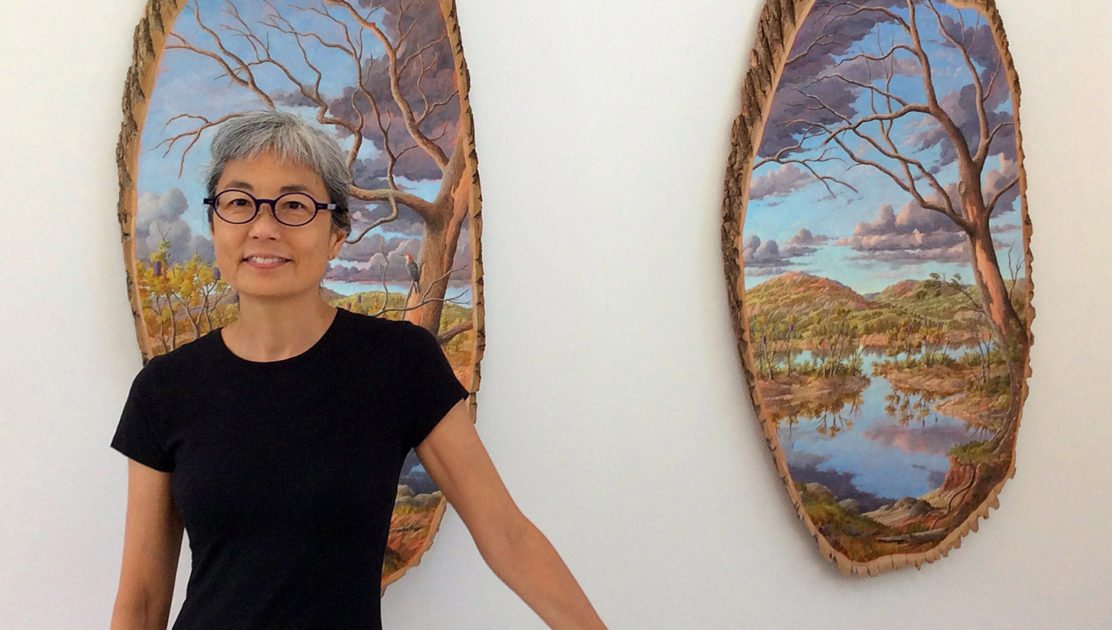Real and Imagined Landscapes
An Interview with Alison Moritsugu
Alison Moritsugu is an artist whose work explores how our idealized images of the natural world shape our concepts about it. In her log paintings, she paints idyllic landscapes in the Hudson River School style on the cross sections of trees, which, as she notes on her website, complicates the image because “any sense of nostalgia or celebration of nature is countered by the evidence of its destruction.”
She recently invited us to her studio in Beacon, New York, to discuss the relationship between real nature and images of nature, integrating our lives and bodies with the world around us, and bringing different cultures together through art.
This post is part of an ongoing series of short interviews on contemplation and creativity.
In your log paintings, you paint pristine natural landscapes on log slices. Any romantic ideas we might have about the landscape are undercut by the log canvas, which implies a disconnection between what we imagine and what’s real. Can you talk about that tension?
I hope to show that there is a vast difference between real nature and an image of nature. I’m not saying, “We should never chop down trees.” I am saying that conservation, forestry, issues concerning the environment are complex, requiring greater awareness and keen observation on our part to find solutions and to implement wiser practices.
When I first began to paint idealized landscapes on sections of real nature, people were often more intrigued by the log than the painting. They would ask me questions like, “Why is there space between the bark and the wood,” or “What are those cracks?” They were used to seeing images of nature, but they had never taken the time to look at an actual log with bark or notice the true behavior of wood.
People had more questions about the log than about the painted image. This reminds me of the selfies taken in nature today. Capturing or snagging the photo is of more importance than really observing and seeing the natural environment. The selfie image now stands in for a real experience in nature.
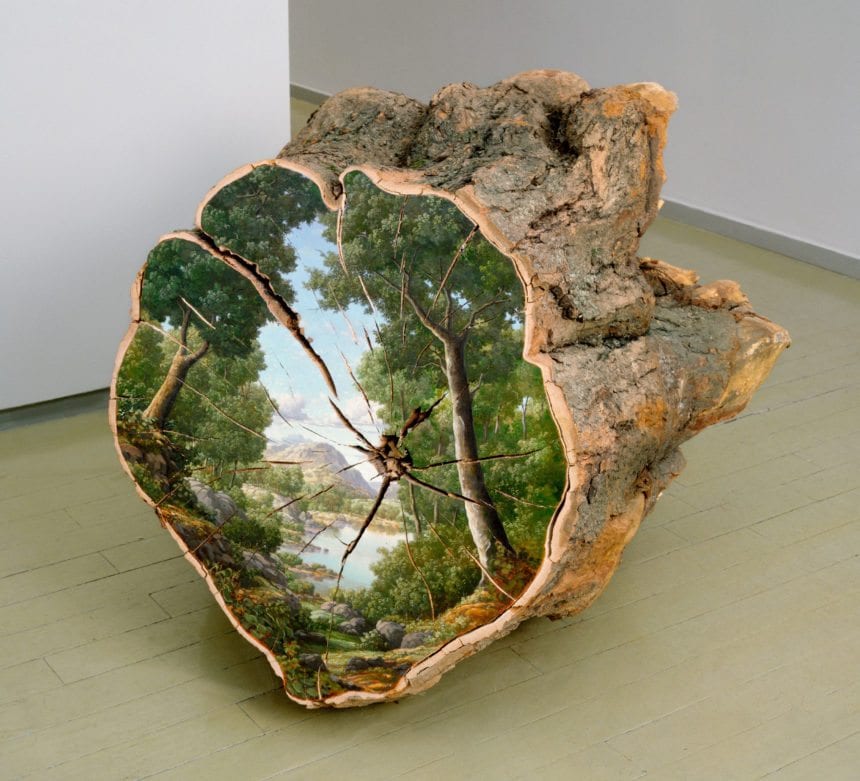
You mentioned that you’re not exactly saying, “We should never chop down trees.” Can you say more about what you are trying to say with your art?
I hope my art makes people more aware of how they experience nature. Do they learn about nature by walking through the woods? Or is their understanding of nature a result of looking at images online or at paintings in museums? It’s important to be aware of where your information about nature is coming from.
When I first started to look at Hudson River School paintings, I noticed that they are carefully arranged, composed and idealized. Artists made sketches during summers and autumns in the Hudson Valley, Adirondacks or Catskills, and then completed the paintings in their New York City studios. They’d add a tree, dramatically heighten the vantage point, or change elements in the composition.
Just because a painting looks like a real landscape doesn’t mean it’s an accurate landscape – it’s still a contrivance made by a human being, affected by his/her own agendas and predispositions.
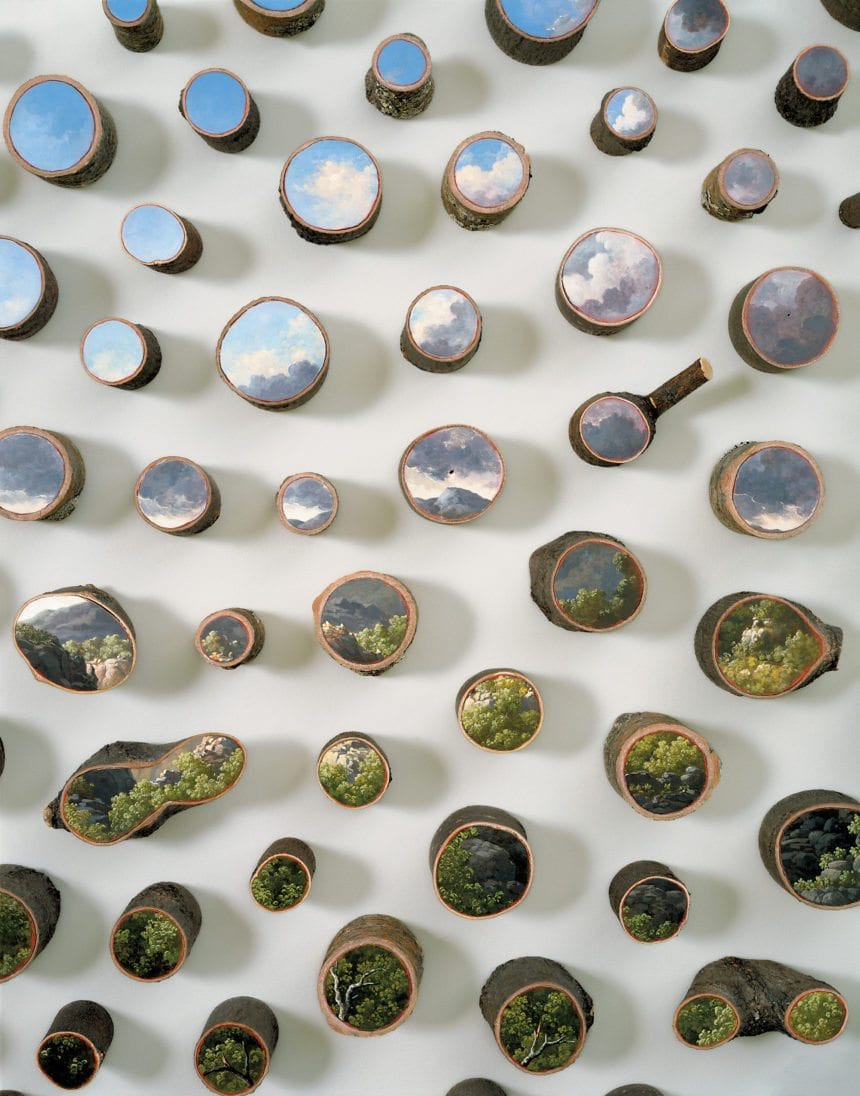
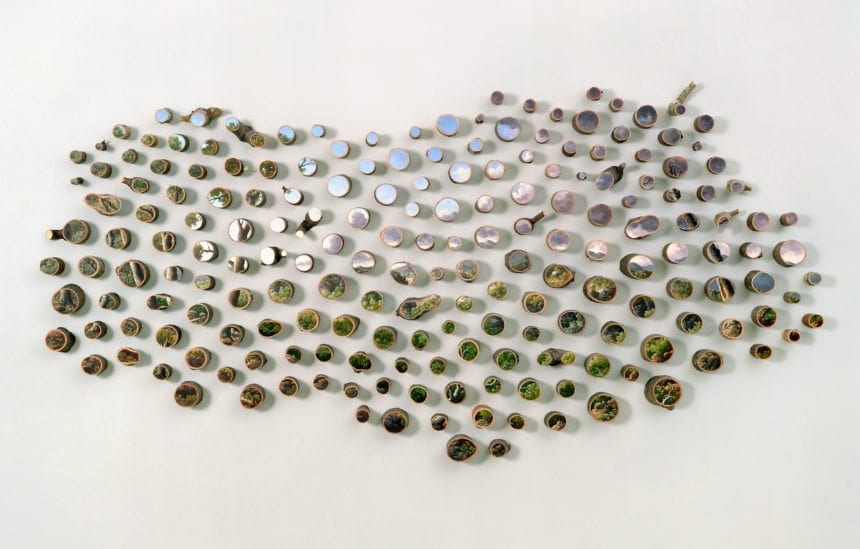
Listening you to talk, I get the impression that you prefer the real hands-on, immersive experience in nature. And yet, here you are making these incredibly beautiful images of the natural world—even while you make a subtle critique of idealizing the image.
I try to make my paintings as beautiful as possible because I’m painting them on an actual log, which is real nature. To me, the painted image works with the log after much time and many layers and glazes of paint have been applied. How do you compete with something that’s real? It’s not something I am able to do with cursory brush strokes. I work hard to make the painting an homage to the log on which it rests.
Yes, your process seems very dynamic in that you pay close attention to the material you’re working with. For example, this pear tree that you’ve covered in tattoos. It looks like you’ve placed the tattoos where it makes sense given the shape of the tree.
When I paint on a log or an object, I want the image to be well integrated with the object’s surface. When I removed the bark and sanded the pear wood log, I noticed the wood had a fleshy color – it looked very much like a torso. I carved designs into the wood so that they complemented the log’s contours and then inlaid those carvings with black pigment, which is basically tattooing. I was tattooing a log, pushing the ink below the surface to create indelible drawings.
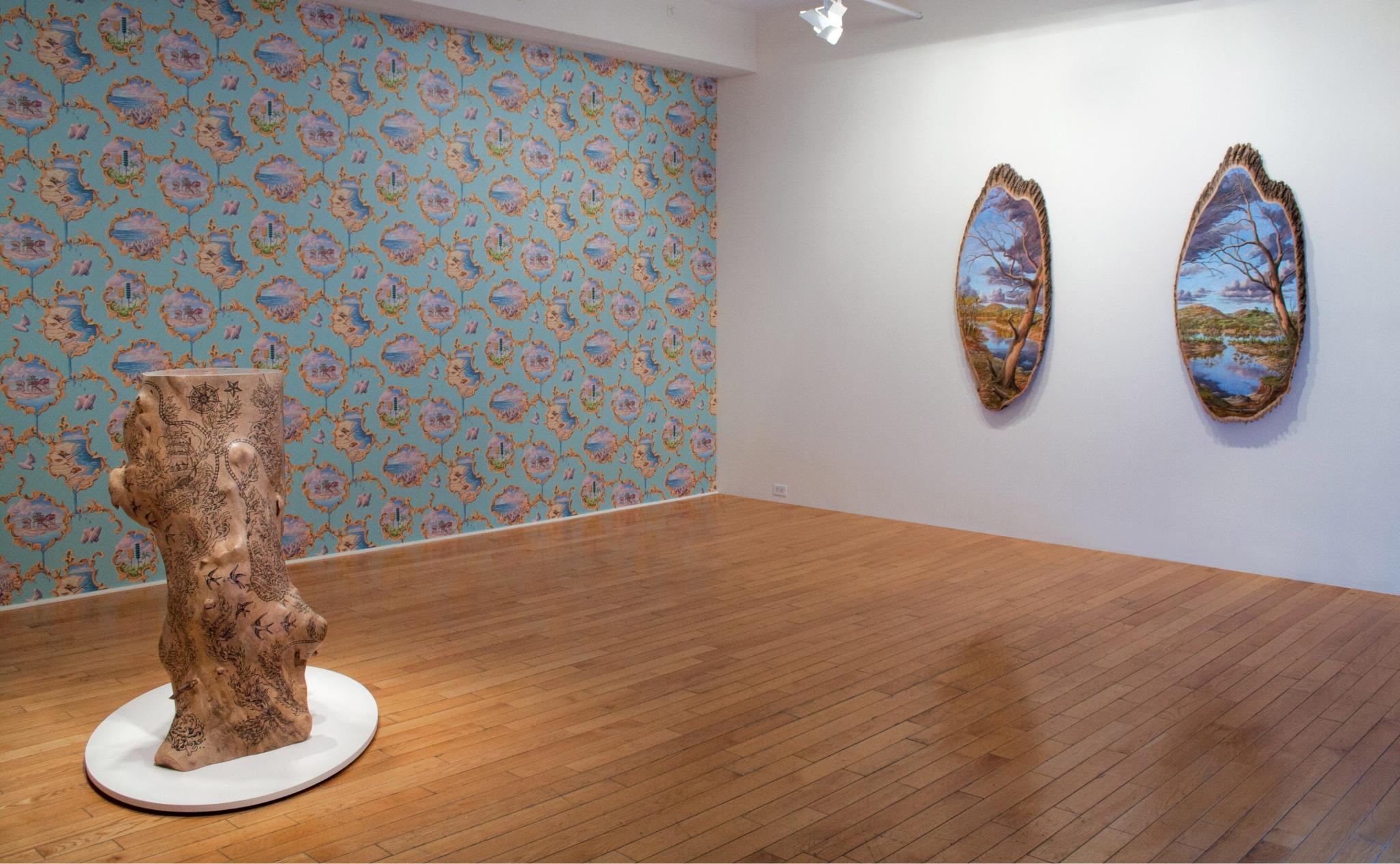
Is this concept of integrating what you do with what the world is offering something that you try to take into your life outside of being an artist? Do you try to live your life in a way that you’re contemplating your surroundings and circumstances and take actions that are in harmony with them?
Yes, I do, but it’s so hard, right? It’s much easier said than done.
This question brings to mind how we orient ourselves in space and how that reflects our awareness of our surroundings. I grew up in Hawaiʻi . Because it’s an island, the coordinates of north, south, east, west had less significance than the Hawaiian directions of mauka (towards the mountains), makai (towards the ocean), ʻEwa and Diamond Head. I oriented myself based on actual land formations and the natural environment and felt this connection in my physical body.
When I went to college in St. Louis, the land was flat, there were no mountains. I had to relearn how to orient myself by using coordinates (north, south, east and west) as touchstones, and I found this very difficult. I’ve learned that more direct, more physical interactions with the environment help me most to live in harmony with my surroundings.
Right. It’s another challenge completely to keep your goals and dreams in sync with what seems possible based on where you are.
It’s the challenge of being present. You want to strike a balance between being aware of what’s happening now and, at the same time, deal with your goals and what you have to do. I think we all struggle with that. I certainly do.
I want to get back to something you hinted at a moment ago when you were talking about the challenge of relearning how to integrate your body with your environment when you moved from Hawaiʻi to St Louis. Part of the challenge is due to the fact that we move around so much. It makes it harder to belong to a place. For instance, sometimes you paint Asian-themed landscapes in the style of the Hudson River School painters.
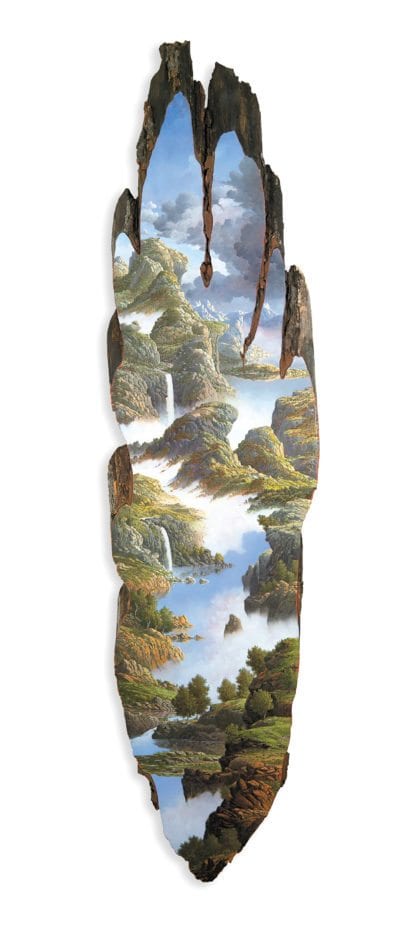 Yes, that duo-culture mashup is always interesting to me. I’ve done paintings on large sassafras slices, some of which are surfboard-shaped and over seven feet tall. Because these are vertical, the traditional European Claudian composition didn’t work. I painted the images in the Hudson River School style, but the composition is based on Chinese landscape paintings. I was most interested in how someone would view the landscape, how their eyes move through the terrain. Because of its verticality, the image can not be grasped in one view like a stage set. You have to travel through it in order to understand it, and your viewing experience and your physical relationship to that landscape is very different.
Yes, that duo-culture mashup is always interesting to me. I’ve done paintings on large sassafras slices, some of which are surfboard-shaped and over seven feet tall. Because these are vertical, the traditional European Claudian composition didn’t work. I painted the images in the Hudson River School style, but the composition is based on Chinese landscape paintings. I was most interested in how someone would view the landscape, how their eyes move through the terrain. Because of its verticality, the image can not be grasped in one view like a stage set. You have to travel through it in order to understand it, and your viewing experience and your physical relationship to that landscape is very different.
It reminds me of the work of Tom Killion, who learned the traditional ways of printmaking in Japan and then applied that technique to the landscapes in Northern California. And poet Gary Snyder has done something similar with writing with the Smokey the Bear Sutra, which was written in the style of a traditional Buddhist text about a beloved mascot in the American West.
Yes, taking something familiar out of its original context can shake things up. We grow accustomed to seeing and experiencing in certain ways. Even the neural connections in our brains become reinforced and habituated to certain ways of thinking with repeated mental experience. It’s very much like turning over a stone and seeing the moist underside for the first time. It’s the same familiar stone, but the colors, smells and shape are completely different. Your experience of the stone is no longer the same and it has forever altered something in you.
Photos courtesy of the artist and Littlejohn Contemporary, NY
